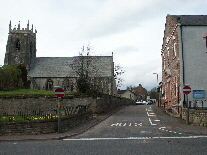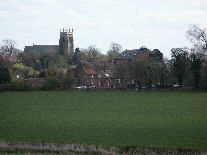|
Topcliffe History Introduction
We know for sure that Topcliffe existed, nearly a thousand years ago, when the Domesday book was compiled for William the Conqueror in 1086. However, tradition has it that the first wooden church was built here four hundred years earlier, by St Aiden or one of the other disciples of St Columba, in about 650 AD. The village itself must have existed here before that to have attracted the attention of St Columba’s disciples.
 After the Conquest of 1066, William the Conqueror gave the Manor of Topcliffe to one of his knights, William de Percy. The Percy’s were later to buy the castle at Alnwick and even later became the Earls of Northumberland. However, the first William de Percy built a castle at the conflux of the Swale and the Codbeck and it became one of his main residences. Later the Percies built themselves a Manor House, which was to play a part in the history of England, on a site adjacent to the castle. After the Conquest of 1066, William the Conqueror gave the Manor of Topcliffe to one of his knights, William de Percy. The Percy’s were later to buy the castle at Alnwick and even later became the Earls of Northumberland. However, the first William de Percy built a castle at the conflux of the Swale and the Codbeck and it became one of his main residences. Later the Percies built themselves a Manor House, which was to play a part in the history of England, on a site adjacent to the castle.
Because of its position on the main north south route, Topcliffe subsequently grew into an important market town and played host to many important Lords and Kings and their Armies. However, with the advent of the industrial revolution Topcliffe’s relative importance gradually declined to the quiet backwater we know today.
There are lots of sources of information about Topcliffe written by various people over the years. Some are serious historical works but others, particularly those written around the early 1900’s didn’t worry too much about historical accuracy. Instead they produced a romanticised version of history and unfortunately some of this mis-information is often repeated in newspaper articles about Topcliffe.
 In the late 1970’s, Mrs M D Watson collated information on the village into a book which she called “Topcliffe”. Now out of print, the book can still be found in the County Library. More recently, at the time of the Millennium, another book on the history of Topcliffe, called the “Millennium Book of Topcliffe” was produced by John M Graham. Using a larger A4, coloured format it covers a wider field than the earlier book. It has lots of photographs and charts and tries to include more recent research. It also tries to discriminate between historical fact and historical fiction and incorporates work from other recent researchers such as that carried out by Linda Nuttall on the Tythe Map and Mr E R Jackson on the Toll Booth. In the late 1970’s, Mrs M D Watson collated information on the village into a book which she called “Topcliffe”. Now out of print, the book can still be found in the County Library. More recently, at the time of the Millennium, another book on the history of Topcliffe, called the “Millennium Book of Topcliffe” was produced by John M Graham. Using a larger A4, coloured format it covers a wider field than the earlier book. It has lots of photographs and charts and tries to include more recent research. It also tries to discriminate between historical fact and historical fiction and incorporates work from other recent researchers such as that carried out by Linda Nuttall on the Tythe Map and Mr E R Jackson on the Toll Booth.
Both of these books can be found on this web site. The earlier book can be downloaded and The Millennium Book of Topcliffe can be obtained as “Real Book” from The Parish Council or on CD by following the instructions on the web site.
John M Graham
|
